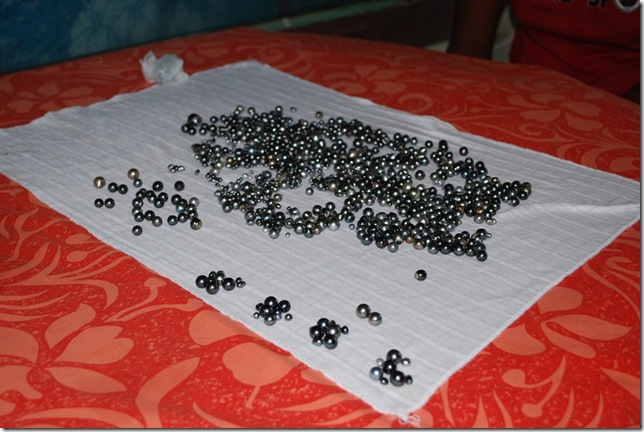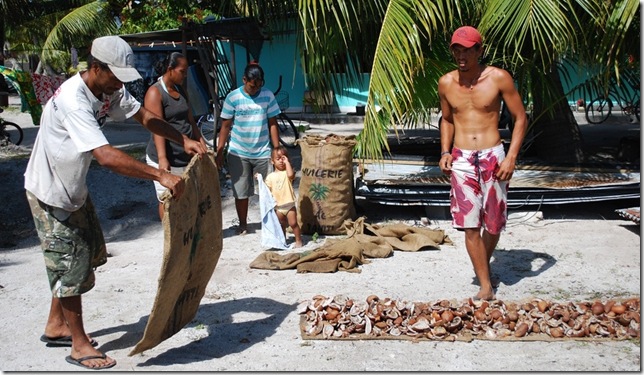We’ve had several firsts here in Kauehi over the last couple of days. Right after writing the last blog, I learned that Wes had caught the first fish. He used Jimmy’s technique of feeding them first and then putting a hook in a piece of food. A banana from Nuku Hiva was the bait that landed the first fish, an aggressive one a little over 2 feet long that had been swimming around the boat with others. It didn’t look like good eating, and we’re not even sure what it was. It sort of looked like a baby shark but had a head that was flat on top with an area that looked like the tread of a tennis shoe.
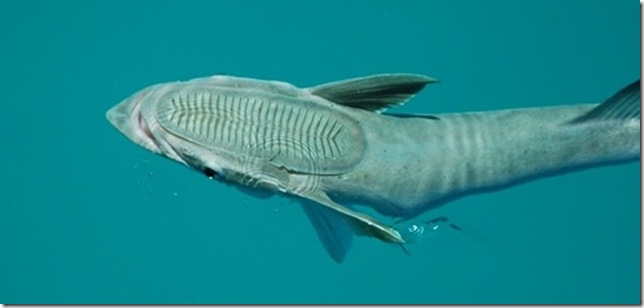 It’s an odd one and it likes bananas
It’s an odd one and it likes bananas
After several missed appointments with the pearl farm owner, we finally asked around and got our first look at some black pearls that one of the locals who works on a pearl farm was selling. Although the pearls you see on the typical necklace are pretty uniform, black pearls in general are anything but homogenous. The colors included silver, gray, green purple, white, and an iridescent color that looked sort of like the different colors that a sheen of oil makes when it’s sitting on top of water. There were of course a few very spherical pearls, but nearly all of the perfect ones go to Tahiti, so the collection we looked at included a wide variety of shapes. Some were sort of lumpy sphere, some just had a small imperfection, some were sort of teardrop-shaped, some looked sort of like spinning tops, and some had cylindrical features. There were also a lot of what were called "kee-shee", which were tiny pearls of many different colors that were shaped a lot like Pop Rocks candy. We picked a few we liked and headed to one of the other boats in the anchorage for a drinks and food.
There were several firsts aboard Na Maka as well. It was the first time we’d visited a French boat, which is one of three anchored here now. Jerome, his wife Natalie, and their three boys (9 and 3-year old twins) are on a Switch 51, which is a beautiful new catamaran equivalent in cost to a small fleet of Pura Vidas. We weren’t sure what to make of them based on our brief conversations from the dinghy, but they turned out to be incredibly nice, very gracious hosts, and informative as well. They’ve spent a lot of time in many different parts of French Polynesia and gave us some good tips on the various places we haven’t visited yet. Jerome also made a really great emerald drink with blue curacao that was, as he put it, "the color of the lagoon." Tiff gave good reviews to her first taste of the giant clams, served with only lime juice, that are common here. We saw purple and blue ones while diving, and apparently they’re several other colors as well..
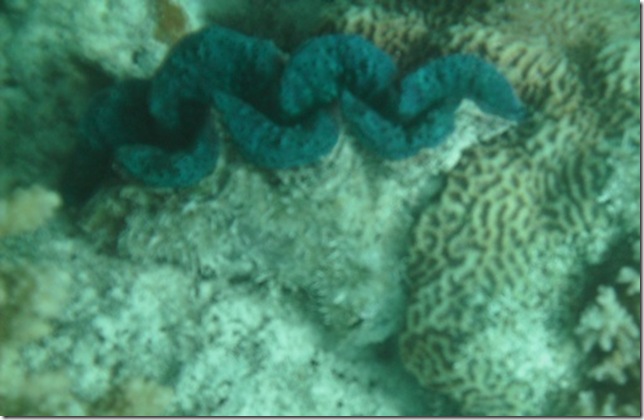 We left this blue giant clam on the coral head
We left this blue giant clam on the coral head
Without us mentioning the random store hours and impossibility of someone keeping an appointment to look at pearls, Natalie and Jerome brought up the local concept of time, which is basically summed up in 3 words — yesterday, today, and tomorrow. Anything that happened in the past naturally happened yesterday, and tomorrow could mean several days or even a month or more. Life is lived for today, and making an appointment for three days from now is the same as saying "we should go fishing together sometime." The inter-island trading boats and Air Tahiti planes are about the only things that seem to keep anything resembling a regular schedule.
A large yellow catamaran named Banana Split had just anchored between us that was single-handed by a man with long graying hair and a full beard that looked not a little like Chong (of Cheech and Chong fame). We thought for sure he must be American, especially when he spoke perfect English, but it turned out he was a Frenchman as well. He was aboard Na Maka when we arrived, so we were introduced to Antoine, who was the first French celebrity we’d chatted with. It turns out he was a famous pop star/idol in the 60’s ("World-famous in France only", he chuckled) that Jerome told us was still well-known by millions. He gave up the pop star life for sailing when he was 30 and a planned 5-6 years of sailing has turned into 34 (including spending most of 2 years in the San Blas islands of eastern Panama after leaving the Galapagos heading West, then turning around after a few days when heading West didn’t feel right). Along the way he’s made 25 documentary films (antoine.tv), mostly travelogues, and written well-known sailing books. Jerome showed us a couple of the books, one of which is considered the French "cruising bible", covering all aspects of offshore sailing and living aboard. Antoine was also an incredibly nice guy, and it’s turns out he’s been here in the Kauehi lagoon for a couple of days anchored in the more remote reaches. Although he’s a very amiable guy, crowds of people aren’t his thing, and he spends most of his time in French Polynesia among the three least-visited archipelagos (Gambier, Australs, and Tuamotus). Visiting the lesser-frequented areas seemed to be a common denominator among all of us and probably explains why we’re the only boats here in Kauehi.
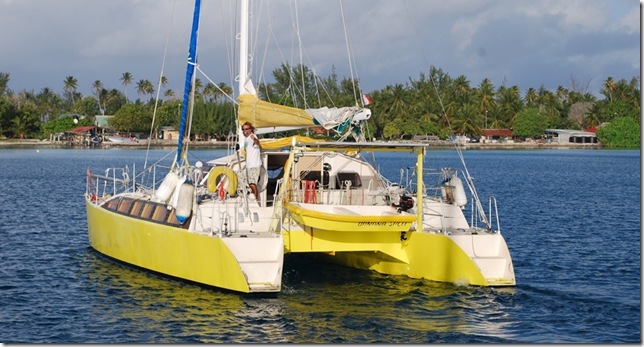 Our friend Antoine on Banana Split
Our friend Antoine on Banana Split
The wind had picked up while we were talking and it was starting to sprinkle, so it was time to go. By the time we got back to the boat, we were all soaked. In addition to rain, the lagoon was choppy enough that we were taking a on a fair amount of seawater over the bow of the dinghy even with the engine at idle speed. Last night was the first real rainstorm we’ve seen in the Pacific. Panama had its afternoon showers, the ITCZ had small scattered squalls, and the Marquesas had a few drizzly hours when the mountains pulled the moisture from the tradewinds, but this was the first actual rainstorm. It rained most of the night and into today, with strong winds from the SSE.
At breakfast, we talked over our itinerary from here to New Zealand and realized once again that the Pacific is a big ocean, with much more to see than we have time for. Fakarava will be our next stop. We’ll probably head there later today or early in the morning if the winds aren’t too bad. We’d like to transit both atoll passes in daylight if possible, and the rainy weather has put a bit of a damper on our plans to photograph the pilgrimage march and city-wide celebration marking the bishop’s visit.


